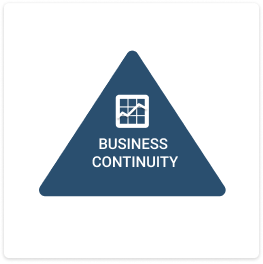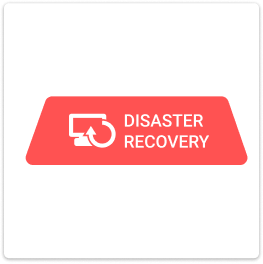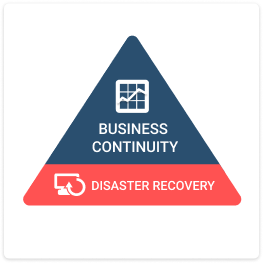BCDR stands for “business continuity and disaster recovery.” This term aggregates the strategy and the collection of approaches that a business needs to implement in order to keep at least mission-critical functions up and running during and after any unplanned event or a disaster.
And the number of such unplanned events and disasters has only been growing during the past decade. Human mistakes, natural disasters, fires, ransomware attacks, and the recent disease outbreak are all forcing business leaders to take business continuity planning seriously.
In this article, we will define the difference between business continuity and disaster recovery, talk about why “BCDR” is an excessive term, and define how business continuity and disaster recovery basics should be used in practice.
Table of Contents
What Is Business Continuity?

Business continuity is advanced action planning that ensures that a business is capable of running its critical business operations in the event of any disruption or emergency while preventing financial losses due to data loss, theft, or cyberattack. It considers a business's readiness to deal with all kinds of unfortunate events and natural disasters.
Before 2020, many IT professionals saw the business continuity concept as an enterprise-only collection of policies, strategies, and other paperwork-and-meeting, C-level nonsense. These IT professionals were only focused on recovering the IT infrastructure or on data recovery. However, due to the pandemic, a lot of businesses were forced to move their workloads away from offices fast and continue to work from their homes. Few were ready for such a sudden change in the business landscape, and IT pros suddenly found themselves solving a number of unexpected questions, such as:
- How do you provide the workforce with stable remote access?
- How do you provide teamwork and file-sharing?
- How do you ensure business security when dozens of employees are working from their homes?
- How do you maintain and support the on-premises infrastructure?
A business continuity strategy aims to answer such questions. It comprises a strategy, a number of policies, and plans that should minimize the risk of disruption in any event. More specifically, business continuity includes:
- Creating a business continuity strategy. A strategy means that the corporate C-level recognizes the dangers posed by business downtime. Hence, the business continuity team is assembled, and their needs are budgeted for.
- Risk evaluation. After the team is assembled, they will need to evaluate all the potential risks that might affect business continuity. Normally, a business impact analysis (BIS) is performed to understand the risks or dangers associated with business disruption. This analysis helps them predict the consequences of some disruptive events on business operations and allows your organization to gather all the information you need to craft the best recovery strategy.
- Creating a plan. Depending on the size of the business and the budget, a business continuity plan can be a highly detailed and structured set of documents that overview how exactly the mission-critical business operations can be recovered to a production state in different cases. Think of it this way – if the whole office building was destroyed, your business continuity plan should be able to answer the questions regarding where you will relocate people and workloads, whom you should contact, and in what order so as to get back to the working state as quickly as possible.
- Plan tests and enhancements. After the plan is created, it needs to be reviewed, tested and, if it does not meet your requirements, enhanced.
- Main components of business continuity,
- Difference between business continuity and related concepts,
- Measurable metrics, and much more.
What Is Disaster Recovery?

Disaster recovery is a set of actions that need to be undertaken in order to recover the IT infrastructure of the company to a working state. Typically, the concept of disaster recovery is included in business continuity. From the strategic and planning point of view, disaster recovery is quite similar to business continuity and includes a disaster recovery strategy and plan.
To develop a disaster recovery plan, you should first develop the granular key recovery metrics for the IT infrastructure of the organization – both recovery time and recovery point objective. These metrics define acceptable downtime and acceptable data loss respectively. By “granular,” we mean that these metrics should be developed for different IT infrastructure subsets on an individual basis.
Further reading Disaster Recovery FAQ: Essential Definitions for IT Pros and MSPs
Business Continuity vs Disaster Recovery: The Difference Explained
Business continuity and disaster recovery plans are similar in that both are important for protecting a business from unexpected events that could cause disruption of routine business operations. But they are distinct concepts. Disaster recovery is a key element of business continuity, which explains the key difference between business continuity and disaster recovery:
 The scope. The business continuity plan refers to all possible business operations, including the movement of employees, the office locations, and the communications between the company and its clients. Disaster recovery, in turn, focuses only on IT infrastructure recovery – data backup and recovery, workload replication, remote access, network resilience, etc. Everyone knows that data loss in an organization can happen due to human error. You can’t afford to lose your critical data, so keeping a proper backup and recovery plan will help you prevent financial losses.
The scope. The business continuity plan refers to all possible business operations, including the movement of employees, the office locations, and the communications between the company and its clients. Disaster recovery, in turn, focuses only on IT infrastructure recovery – data backup and recovery, workload replication, remote access, network resilience, etc. Everyone knows that data loss in an organization can happen due to human error. You can’t afford to lose your critical data, so keeping a proper backup and recovery plan will help you prevent financial losses.
The point in time. With business continuity, the company typically focuses on the processes during and right after a disaster, while disaster recovery is geared towards processes happening after disruptive events.
Span difference. The business continuity concept includes a long-term strategy for the company to reduce downtime, while disaster recovery eliminates the exact risks during a set period of time (RTO and RPO).
BCDR: Matching Disaster Recovery to Business Continuity
As we stated earlier, “BCDR” is an excessive term. You already know that business continuity includes disaster recovery; hence, there is no need to separate business continuity from disaster recovery and then group them into a single term. This will only create terminological chaos.
From a practical point of view, it is best to define business continuity as the package of strategies, policies, and practices to keep the business afloat, including disaster recovery; and disaster recovery, as an integral part of business continuity, should address all IT-related questions.
How You Should Change Your Business Continuity and Disaster Recovery Plans in 2024
The landscape and the understanding of business continuity for the masses is changing all the time. Previously, the business continuity concept was popular among enterprise-grade companies or those who worked in locations with a high chance of natural disaster. These companies developed resilience and disaster recovery plans.
Here's what you should include in the BCDR plan:
- Work-from-home policy. Now you know that disaster strikes unexpectedly, but business disruptions should still be minimized. Develop a work-from-home policy on the basis of what you've learned during the pandemic. The policy should include remote access, bring-your-own-device, and remote workforce security considerations.
- The new layer of security. One office building with dozens of employees is a challenge for cybersecurity. But once employees are at home, you have dozens of possible points of intrusion, and you cannot always directly control security. You need to create a security education program for employees, perform penetration tests, create a security policy appropriate to the bring-your-own-device approach, and add them to your BCDR plan.
- Focus on employee safety. Your first priority should be to maximize your employees’ safety.
- Cloud migration. During work-from-home, on-premises hardware becomes a nightmare to support on-site. Thus, it's a good time to think about migrating to cloud services.
- Disaster response team. When the unexpected happens, someone should be responsible for what the company does. So, create a response team that knows the business continuity action plan.
- Force majeure clauses. Review whether or not your master service agreement has force majeure clauses. If not – add them.
Conclusion
On paper, the business continuity concept is a mess of half-technological and half-business-related terms, policies, strategies, and teams. However, once you get a clear picture of the difference between business continuity and disaster recovery, and once you apply business continuity and disaster recovery basics to your unique case, you will be able to work out a continuous approach to safeguarding your or your clients’ businesses from downtime.








